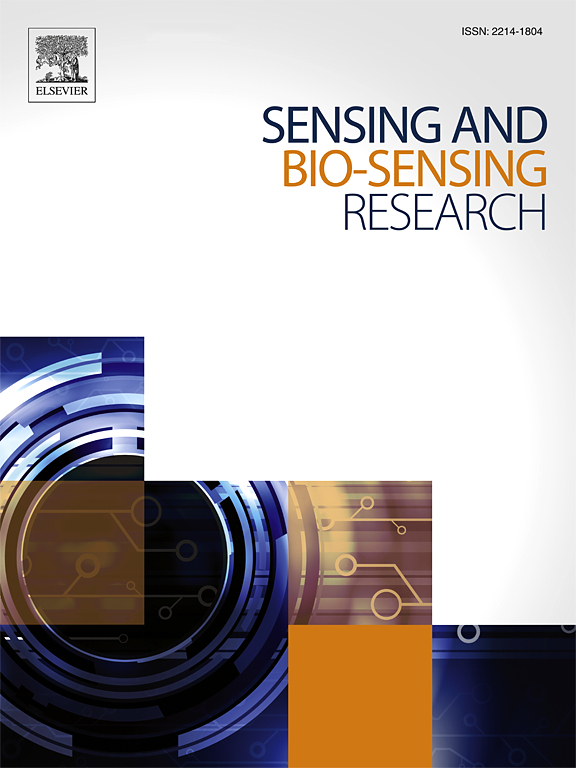Wheat Germ Agglutinin physisorption on Love Surface Acoustic Wave sensor for biofluid analysis
IF 4.9
Q1 CHEMISTRY, ANALYTICAL
引用次数: 0
Abstract
Biosensors play an essential role in the detection of biomarkers, enabling precise and early diagnosis as well as effective monitoring of diseases. However, conventional immobilization techniques for biosensors, such as covalent attachment and silanization, often require harsh chemical treatments that can alter the structure and activity of bioreceptors, limiting their effectiveness. As an alternative, physisorption offers a milder approach, preserving biomolecular activity by relying on non-covalent interactions. When combined with the Love Surface Acoustic Wave (LSAW) transducer—a highly sensitive technology for biosensing applications—physisorption presents a promising strategy for developing efficient biosensors. In this study, a gold-coated LSAW sensor was used to investigate the physisorption of Wheat Germ Agglutinin (WGA) lectin. A sensing system prototype was developed and characterized to assess sensor response across different WGA concentrations in a pH 9 buffer aligned with WGA isoelectric point. The obtained biosensor was tested with human reflex tears at different dilution levels to evaluate the signal response of putative WGA-binding molecules. Results confirmed that physisorption is a robust and reliable immobilization technique. Moreover, integrating LSAW sensors with physisorption creates an innovative biosensing strategy, enabling high-sensitivity detection in complex biological fluids. This advancement underscores its significant potential for supporting tear-based diagnostics and expanding its applications in biomedical analysis.

小麦胚芽凝集素在Love表面声波传感器上的物理吸附
生物传感器在检测生物标志物方面发挥着至关重要的作用,可以实现精确和早期诊断以及有效监测疾病。然而,传统的生物传感器固定技术,如共价附着和硅烷化,通常需要苛刻的化学处理,可以改变生物受体的结构和活性,限制其有效性。作为一种替代方案,物理吸附提供了一种更温和的方法,通过依赖非共价相互作用来保持生物分子活性。当与Love表面声波(LSAW)换能器(一种用于生物传感应用的高灵敏度技术)相结合时,物理吸收为开发高效的生物传感器提供了一种有前途的策略。本研究采用金包覆LSAW传感器对小麦胚芽凝集素(WGA)的物理吸附进行了研究。开发了传感系统原型,并对其进行了表征,以评估传感器对不同WGA浓度的响应,缓冲液pH为9,与WGA等电点对齐。所获得的生物传感器在不同稀释水平的人类反射眼泪中进行测试,以评估假定的wga结合分子的信号响应。结果证实物理吸附是一种稳健可靠的固定技术。此外,将LSAW传感器与物理吸附相结合,创造了一种创新的生物传感策略,可以在复杂的生物流体中进行高灵敏度检测。这一进展强调了它在支持基于眼泪的诊断和扩大其在生物医学分析中的应用方面的巨大潜力。
本文章由计算机程序翻译,如有差异,请以英文原文为准。
求助全文
约1分钟内获得全文
求助全文
来源期刊

Sensing and Bio-Sensing Research
Engineering-Electrical and Electronic Engineering
CiteScore
10.70
自引率
3.80%
发文量
68
审稿时长
87 days
期刊介绍:
Sensing and Bio-Sensing Research is an open access journal dedicated to the research, design, development, and application of bio-sensing and sensing technologies. The editors will accept research papers, reviews, field trials, and validation studies that are of significant relevance. These submissions should describe new concepts, enhance understanding of the field, or offer insights into the practical application, manufacturing, and commercialization of bio-sensing and sensing technologies.
The journal covers a wide range of topics, including sensing principles and mechanisms, new materials development for transducers and recognition components, fabrication technology, and various types of sensors such as optical, electrochemical, mass-sensitive, gas, biosensors, and more. It also includes environmental, process control, and biomedical applications, signal processing, chemometrics, optoelectronic, mechanical, thermal, and magnetic sensors, as well as interface electronics. Additionally, it covers sensor systems and applications, µTAS (Micro Total Analysis Systems), development of solid-state devices for transducing physical signals, and analytical devices incorporating biological materials.
 求助内容:
求助内容: 应助结果提醒方式:
应助结果提醒方式:


